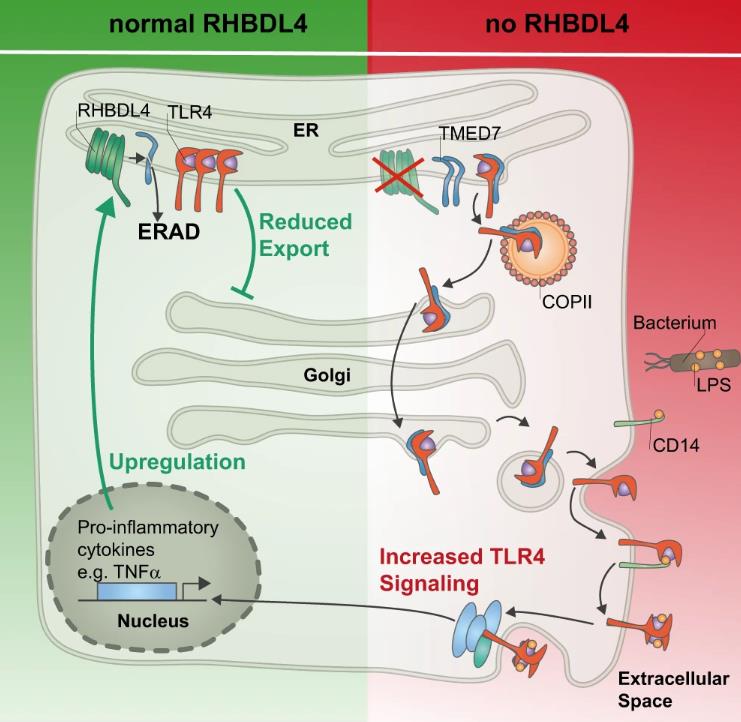Toll-like receptor 4 (TLR4) is a central regulatory factor of innate immunity in the body, mainly able to recognize the lipopolysaccharide cell wall components of bacteria and induce cytokine release.
Recently, a research report titled “RHBDL4-triggered downregulation of COPII adaptor protein TMED7 suppresses TLR4-mediated inflammatory signaling” was published in Nature Communications. Scientists from institutions such as the University of Cologne found through their research that the membrane protease RHBDL4 may effectively prevent the occurrence of excessive immune responses in the body.
Our Featured Products
| Cat. No. | Product Name | Source (Host) | Species | Tag |
| TLR4-296H | Active Recombinant Human TLR4/LY96 Complex Protein, His-tagged | Mammalian cells | Human | His |
| TLR4-7275H | Recombinant Human TLR4, His tagged | Insect Cells | Human | His |
| RHBDL3-2287H | Recombinant Human RHBDL3, GST-tagged | E.coli | Human | GST |
| TMED7-6102R | Recombinant Rat TMED7 Protein | Mammalian Cell | Rat | His |
| TMED7-5759R | Recombinant Rat TMED7 Protein, His (Fc)-Avi-tagged | HEK293 | Rat | His (Fc)-Avi |
In the article, researchers found that the cleavage of cargo receptors by so-called membrane proteases reduces the localization of central immune receptors on the cell surface, thereby reducing the risk of immune system overreaction in the body.
Intramembrane proteases are active proteins located in the cell membrane, which can form a special group of proteases because they can cleave proteins within the cell membrane. At present, researchers have not fully described the unusual proteases involved, and there are only some molecules known to be capable of cleavage (i.e. substrates), so their functions are still unknown. One of the membrane proteases is RHBDL4, which is located in the endoplasmic reticulum, a larger membrane system in cells that is primarily responsible for correctly folding newly synthesized proteins and subsequently feeding them into the secretion pathway. When searching for the molecular functions of substrates and RHBDL4, researchers have discovered a mechanism that regulates the innate immune system in the body, including cleaving transport proteins to block the transport of immune receptors to the cell surface.

To gain a preliminary understanding of the physiological function of RHBDL4, researchers used mass spectrometry to analyze substrates of tissue-cultured cells. Among the candidate substrates are various so-called cargo receptors, which are necessary for the transport of specific proteins in the secretion pathway. Contrary to long-term assumptions, most proteins are not simply secreted from the endoplasmic reticulum in a non-specific manner, but must be selected and transported by cargo receptors, one of which, such as TMED7, can be characterized as a substrate for RHBDL4. By cleaving this cargo receptor, cells can precisely and quickly control the transportation of specific proteins to adapt to given environmental conditions. Currently, researchers have not described the molecular mechanism behind regulating the transportation process by cleaving cargo receptors through membrane proteases.
This research finding is very interesting because the cargo receptor TMED7 can transport the central immune receptor (TLR4) in the innate immune system to the cell surface. When TLR4 comes into contact with components of bacterial cell walls, it induces an immune response (i.e. defense response). RHBDL4’s cleavage of the cargo receptor TMED7 leads to a small amount of TLR4 molecules reaching the cell surface, thereby reducing the immune response to bacterial cell wall components.
Because excessive activation of TLR4 can damage organisms and even promote the occurrence of blood poisoning (sepsis), the immune response mediated by TLR4 must be strictly regulated by the body. After studying using mouse models, researchers found that RHBDL4 is particularly important in preventing excessive activation of TLR4, which may protect the body.
Researcher Lemberg said that when receptors are stimulated, cells produce more RHBDL4, which is why there is a negative feedback loop, as it can prevent excessive immune responses from receptors from damaging the body.
To gain a better understanding of the clinical relevance of RHBDL4 in transport regulation, researchers found through joint research that this regulation becomes particularly important when exposed to bacteria such as Mycobacterium tuberculosis. In addition, researchers have linked genetic mutations in the protease RHBDL4 to Kawasaki syndrome, an immunological disease associated with immune system overreaction that often affects children’s health. This research project demonstrates the use of very simple models such as tissue culture cells to reveal new insights into human biology and diseases.
In summary, in this study, researchers identified that the axis mediated by RHBDL4 may serve as a “rheostat” to prevent over-activation of the TLR4 pathway.
Related Products and Services
Protein Expression and Purification Services
Reference
Knopf, J.D., Steigleder, S.S., Korn, F. et al. RHBDL4-triggered downregulation of COPII adaptor protein TMED7 suppresses TLR4-mediated inflammatory signaling. Nat Commun 15, 1528 (2024). doi:10.1038/s41467-024-45615-2